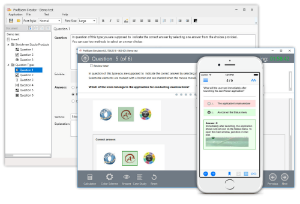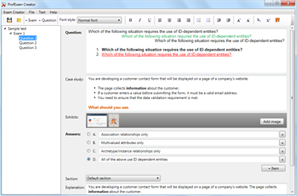File Info
| Exam | VMware vRealize Operations Specialist |
| Number | 5V0-35.21 |
| File Name | VMware.5V0-35.21.VCEplus.2025-04-02.82q.tqb |
| Size | 794 KB |
| Posted | Apr 02, 2025 |
| Download | VMware.5V0-35.21.VCEplus.2025-04-02.82q.tqb |
How to open VCEX & EXAM Files?
Files with VCEX & EXAM extensions can be opened by ProfExam Simulator.
Coupon: MASTEREXAM
With discount: 20%
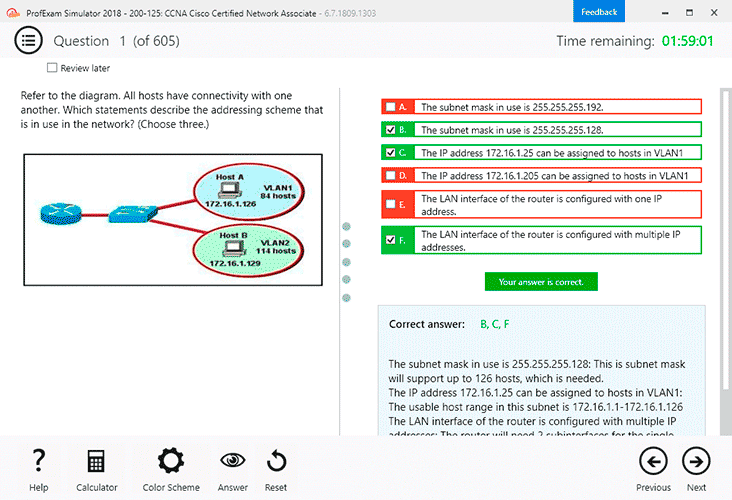

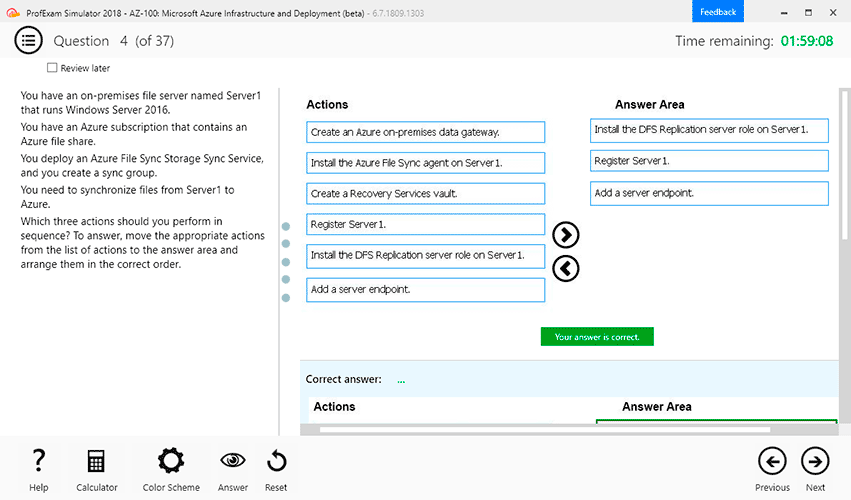
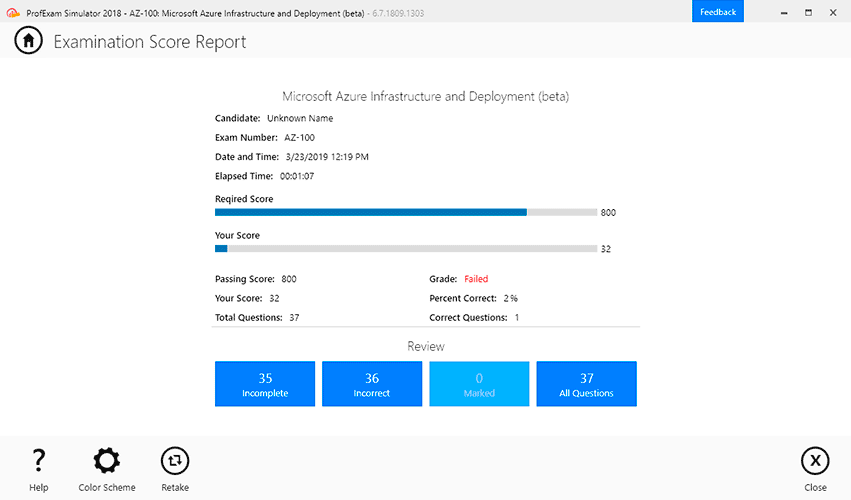
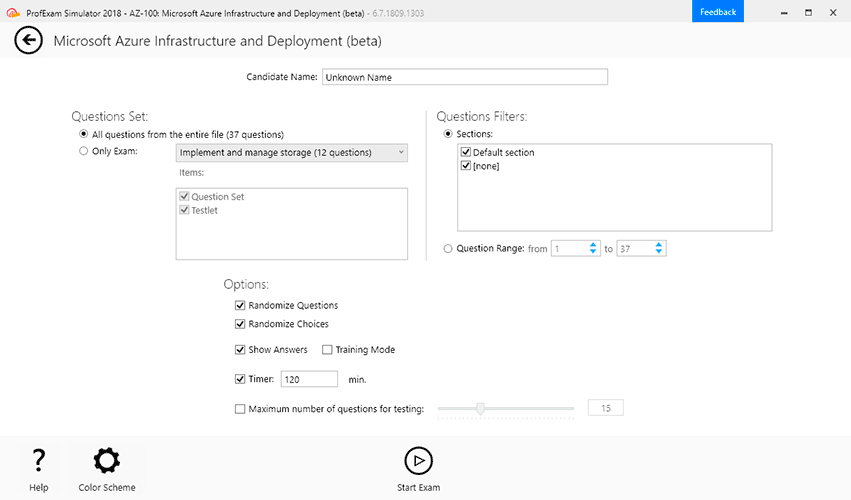

Demo Questions
Question 1
An administrator has created a new super metric on one of the vRealize Operations instance and would now like to consistently apply it to the other vRealize Operations instances in the environment using a JSON file.
Which step should be used to complete this task on other destination vRealize Operations instances to configure the super metric?
An administrator has created a new super metric on one of the vRealize Operations instance and would now like to consistently apply it to the other vRealize Operations instances in the environment using a JSON file.
Which step should be used to complete this task on other destination vRealize Operations instances to configure the super metric?
- Export the super metric
- Import the super metric
- Add the super metric
- 'Update the super metric
Correct answer: B
Explanation:
To apply a super metric to other vRealize Operations instances, you need to export the super metric from the source instance and import it to the destination instance. Exporting a super metric creates a JSON file that contains the super metric definition and attributes. Importing a super metric allows you to upload the JSON file and add the super metric to the destination instance. You can also choose to overwrite or skip an existing super metric with the same name. Adding or updating a super metric are not the correct steps, as they are used to create or modify a super metric within the same instance.References:Exporting and Importing a Super Metric To apply a super metric to other vRealize Operations instances, you need to export the super metric from the source instance and import it to the destination instance. Exporting a super metric creates a JSON file that contains the super metric definition and attributes. Importing a super metric allows you to upload the JSON file and add the super metric to the destination instance. You can also choose to overwrite or skip an existing super metric with the same name. Adding or updating a super metric are not the correct steps, as they are used to create or modify a super metric within the same instance.
References:Exporting and Importing a Super Metric
Question 2
A customer wants to monitor a remote datacenter using an existing vRealize Operations Manager cluster. The round-trip time (RTT) between datacenters is 150 ms.
Which type of node should be deployed?
- IRemote Collector node
- Replica node
- Data node
- witness node
Correct answer: A
Explanation:
The type of node that should be deployed to monitor a remote datacenter using an existing vRealize Operations Manager cluster is a Remote Collector node. A Remote Collector node is a node that is deployed in a remote datacenter location across a firewall, and collects data from the remote objects without performing analysis or storing data.A Remote Collector node can reduce the bandwidth consumption and the load on the vRealize Operations analytics cluster, and can also navigate firewalls and interface with remote data sources12.A Remote Collector node can be deployed on a different operating system than the rest of the cluster, and can support a round-trip time (RTT) of up to 200 ms3.The other options are not correct, because they are not suitable for monitoring a remote datacenter with a high RTT. A Replica node is a node that is converted from a Data node to provide high availability (HA) or continuous availability (CA) for the vRealize Operations cluster.A Replica node is a copy of the Primary node, and must be deployed in the same datacenter as the Primary node1. A Data node is a node that performs data collection and analysis for the vRealize Operations cluster, and can be added to scale out the cluster capacity and performance.A Data node must be deployed in the same datacenter as the Primary node, and can support a RTT of up to 10 ms1. A Witness node is a node that is required for continuous availability (CA) of the vRealize Operations cluster, and acts as a decision maker in case of a network partition between two fault domains.A Witness node must be deployed in a third datacenter that is separate from the two fault domains, and can support a RTT of up to 100 ms1.References:About vRealize Operations Cluster Nodes - VMware DocsvRealize Operations Manager: Design Introduction - VMware BlogsMastering vRealize Operations Manager - Second Edition - Packt SubscriptionvRealize Operations node types - Mastering vRealize Operations Manager ... The type of node that should be deployed to monitor a remote datacenter using an existing vRealize Operations Manager cluster is a Remote Collector node. A Remote Collector node is a node that is deployed in a remote datacenter location across a firewall, and collects data from the remote objects without performing analysis or storing data.A Remote Collector node can reduce the bandwidth consumption and the load on the vRealize Operations analytics cluster, and can also navigate firewalls and interface with remote data sources12.A Remote Collector node can be deployed on a different operating system than the rest of the cluster, and can support a round-trip time (RTT) of up to 200 ms3.
The other options are not correct, because they are not suitable for monitoring a remote datacenter with a high RTT. A Replica node is a node that is converted from a Data node to provide high availability (HA) or continuous availability (CA) for the vRealize Operations cluster.A Replica node is a copy of the Primary node, and must be deployed in the same datacenter as the Primary node1. A Data node is a node that performs data collection and analysis for the vRealize Operations cluster, and can be added to scale out the cluster capacity and performance.A Data node must be deployed in the same datacenter as the Primary node, and can support a RTT of up to 10 ms1. A Witness node is a node that is required for continuous availability (CA) of the vRealize Operations cluster, and acts as a decision maker in case of a network partition between two fault domains.A Witness node must be deployed in a third datacenter that is separate from the two fault domains, and can support a RTT of up to 100 ms1.
References:
About vRealize Operations Cluster Nodes - VMware Docs
vRealize Operations Manager: Design Introduction - VMware Blogs
Mastering vRealize Operations Manager - Second Edition - Packt Subscription
vRealize Operations node types - Mastering vRealize Operations Manager ...
Question 3
Which vRealize Operations objects can be used to create a dashboard?
- Alerts
- Views
- Recommendations
- Reports
Correct answer: B
Explanation:
To view the status of all objects in vRealize Operations, you can create a dashboard by adding widgets or views. You can create and modify dashboards and configure them to meet your environment needs. Widgets are graphical elements that display data and analysis from vRealize Operations. Views are predefined or custom presentations of object data that you can use in dashboards, reports, or alerts. Alerts, recommendations, and reports are not objects that can be used to create dashboards, but they can be displayed or accessed from dashboards.References:Create and Configure DashboardsDashboardsvROPS Dashboards Overview To view the status of all objects in vRealize Operations, you can create a dashboard by adding widgets or views. You can create and modify dashboards and configure them to meet your environment needs. Widgets are graphical elements that display data and analysis from vRealize Operations. Views are predefined or custom presentations of object data that you can use in dashboards, reports, or alerts. Alerts, recommendations, and reports are not objects that can be used to create dashboards, but they can be displayed or accessed from dashboards.
References:
Create and Configure Dashboards
Dashboards
vROPS Dashboards Overview
Question 4
Which capability is available in the cloud services console, regardless of the subscribed cloud services?
- Organization Access Management
- Identity & Access Management
- Settings
- Cost Insights
Correct answer: B
Explanation:
According to the VMware vRealize Operations Reference Materials, the cloud services console is a unified interface that allows you to access and manage your VMware Cloud services. The Identity & Access Management capability is available in the cloud services console regardless of the subscribed cloud services, as it enables you to manage users, groups, roles, and permissions for your organization. The other capabilities, such as Organization Access Management, Settings, and Cost Insights, are specific to certain cloud services and may not be available for all subscriptions.References:Cloud Services Console OverviewIdentity & Access Management Overview According to the VMware vRealize Operations Reference Materials, the cloud services console is a unified interface that allows you to access and manage your VMware Cloud services. The Identity & Access Management capability is available in the cloud services console regardless of the subscribed cloud services, as it enables you to manage users, groups, roles, and permissions for your organization. The other capabilities, such as Organization Access Management, Settings, and Cost Insights, are specific to certain cloud services and may not be available for all subscriptions.
References:
Cloud Services Console Overview
Identity & Access Management Overview
Question 5
Which option should an administrator select to achieve the lowest cost in Workload Optimization?
- Balance
- Efficiency
- Shrink
- Consolidate
Correct answer: D
Explanation:
To achieve the lowest cost in Workload Optimization, the administrator should select the Consolidate option, which will place VMs into as few clusters as possible, but allows for less responsive capacity.This is good for populations with steady demand and may reduce licensing and hardware costs, such as power and cooling1.The Consolidate option is one of the three operational intents that can be selected for Workload Optimization, along with Balance and Moderate2. The Balance option will spread VMs evenly over the available resources, but may move VMs more often.The Moderate option will minimize VM contention, but will not attempt to move VMs to achieve better balance or consolidation1.References:1:Optimize Performance with VMware vRealize Operations2:Self-Driving Operations by VMware vRealize Operations Datasheet To achieve the lowest cost in Workload Optimization, the administrator should select the Consolidate option, which will place VMs into as few clusters as possible, but allows for less responsive capacity.This is good for populations with steady demand and may reduce licensing and hardware costs, such as power and cooling1.The Consolidate option is one of the three operational intents that can be selected for Workload Optimization, along with Balance and Moderate2. The Balance option will spread VMs evenly over the available resources, but may move VMs more often.The Moderate option will minimize VM contention, but will not attempt to move VMs to achieve better balance or consolidation1.
References:1:Optimize Performance with VMware vRealize Operations2:Self-Driving Operations by VMware vRealize Operations Datasheet
Question 6
The data to be monitored with Telegraf Agent is not one of the out-of-the-box options for monitoring.
Which option may be used for collecting data from this application?
- Proxy Script
- Custom Script
- Advanced Agent
- Custom Agent
Correct answer: B
Explanation:
A custom script is a way to collect data from an application that is not supported by the default Telegraf plugins1.A custom script can be written in any language that can run on the end point VM, such as Python, PowerShell, or Bash2.The custom script must output the data in a specific format that can be parsed by the Telegraf agent and sent to vRealize Operations3.The custom script can be configured in the telegraf.conf file or in a separate file under the /etc/telegraf/telegraf.d/ directory4.References:1: Telegraf Agent - VMware Docs(https://docs.vmware.com/en/vRealize-Operations/8.10/com.vmware.vcom.config.doc/GUID-0C121456-370C-467E-874B-38ACC93E3776.html)2: Custom Script - VMware Docs(https://docs.vmware.com/en/vRealize-Operations/8.10/com.vmware.vcom.core.doc/GUID-9614C495-FAE0-4E95-8EE2-6FDA57355C0E.html)3: Custom Script OutputFormat - VMware Docs(https://www.funkycloudmedina.com/2022/06/how-to-install-vrealize-operations-telegraf-agent-using-vrealize-automation-and-saltstack-config/)4: Configure Telegraf Agent - VMware Docs(https://www.brockpeterson.com/post/windows-service-monitoring-with-vmware-vrealize-operations) A custom script is a way to collect data from an application that is not supported by the default Telegraf plugins1.A custom script can be written in any language that can run on the end point VM, such as Python, PowerShell, or Bash2.The custom script must output the data in a specific format that can be parsed by the Telegraf agent and sent to vRealize Operations3.The custom script can be configured in the telegraf.conf file or in a separate file under the /etc/telegraf/telegraf.d/ directory4.
References:1: Telegraf Agent - VMware Docs(https://docs.vmware.com/en/vRealize-Operations/8.10/com.vmware.vcom.config.doc/GUID-0C121456-370C-467E-874B-38ACC93E3776.html)2: Custom Script - VMware Docs(https://docs.vmware.com/en/vRealize-Operations/8.10/com.vmware.vcom.core.doc/GUID-9614C495-FAE0-4E95-8EE2-6FDA57355C0E.html)3: Custom Script Output
Format - VMware Docs(https://www.funkycloudmedina.com/2022/06/how-to-install-vrealize-operations-telegraf-agent-using-vrealize-automation-and-saltstack-config/)4: Configure Telegraf Agent - VMware Docs(https://www.brockpeterson.com/post/windows-service-monitoring-with-vmware-vrealize-operations)
Question 7
What is a characteristic of an alert recommendation?
- It updates objects or read data about objects in monitored systems.
- It is a probable solution for resolving the problem that triggered the alert.
- It is always linked to a corresponding Knowledge Base article.
- Alert recommendations are only available as part of an installed Management Pack, so creating custom recommendations is not possible.
Correct answer: B
Explanation:
Alert recommendations are the remediation options that you provide to your users to resolve the problems that the generated alert indicates. When you add an alert definition that indicates a problem with objects in your monitored environment, add a relevant recommendation.Recommendations can be instructions to your users, links to other information or instruction sources, or vRealize Operations actions that run on the target systems1.Alert recommendations are not always linked to a Knowledge Base article, and they can be created or modified by the user2.References:1:Defining Alerts in vRealize Operations2:User Scenario: Monitor and Process Alerts in vRealize Operations Manager Alert recommendations are the remediation options that you provide to your users to resolve the problems that the generated alert indicates. When you add an alert definition that indicates a problem with objects in your monitored environment, add a relevant recommendation.Recommendations can be instructions to your users, links to other information or instruction sources, or vRealize Operations actions that run on the target systems1.Alert recommendations are not always linked to a Knowledge Base article, and they can be created or modified by the user2.
References:1:Defining Alerts in vRealize Operations2:User Scenario: Monitor and Process Alerts in vRealize Operations Manager
Question 8
Which type of node can function as a NTP server for the vRealize Operations cluster when the cluster is behaving normally, and there are no errors or issues in the existing cluster?
- IRemote collector nodes
- Replica nodes
- Primary nodes
- Data nodes
Correct answer: C
Explanation:
According to the VMware vRealize Operations Reference Materials, primary nodes are responsible for managing the cluster configuration and synchronizing data across the cluster. They can also function as NTP servers for the cluster, ensuring that all nodes have the same time settings. Remote collector nodes, replica nodes, and data nodes rely on the primary nodes for NTP settings and cannot act as NTP servers themselves.References:vRealize Operations Manager Cluster Node Types Configuring NTP Settings According to the VMware vRealize Operations Reference Materials, primary nodes are responsible for managing the cluster configuration and synchronizing data across the cluster. They can also function as NTP servers for the cluster, ensuring that all nodes have the same time settings. Remote collector nodes, replica nodes, and data nodes rely on the primary nodes for NTP settings and cannot act as NTP servers themselves.
References:
vRealize Operations Manager Cluster Node Types Configuring NTP Settings
Question 9
There is a planned project to move some workloads from a company's vSphere environment, which is running in their data center, to a public cloud. The vSphere environment is being monitored by vRealize Operations. An administrator has been asked to get a monthly cost estimate for running the workloads in a public cloud.
What are two of the public cloud providers that are supported out-of-the-box in vRealize Operations What-If planning for public cloud costs? (Choose two.)
- Microsoft Azure
- Salesforce Cloud
- Oracle Cloud
- Alibaba Cloud
- Google Cloud
Correct answer: AE
Explanation:
According to the VMware vRealize Operations Reference Materials, two of the public cloud providers that are supported out-of-the-box in vRealize Operations What-If planning for public cloud costs are Microsoft Azure and Google Cloud. The What-If planning feature allows the administrator to compare the cost of running workloads in different public cloud providers, such as AWS, IBM Cloud, Microsoft Azure, Google Cloud, and Alibaba Cloud.The administrator can select the public cloud provider, the region, and the instance type, and then run the scenario to see the estimated monthly cost for the selected workloads. The administrator can also compare up to three public cloud providers at a time. The other options are incorrect because they are not supported out-of-the-box in vRealize Operations What-If planning for public cloud costs. Salesforce Cloud and Oracle Cloud are not among the public cloud providers that are available by default in vRealize Operations. However, the administrator can create a custom public cloud provider and upload a rate card to include them in the What-If planning.Alibaba Cloud is supported out-of-the-box in vRealize Operations What-If planning for public cloud costs, but it is not one of the correct answers, as only two options are required.References:What-If-Analysis - Migration Planning: Public Cloud;VMware vRealize Operations What-If Analysis;VMware vRealize Operations for Public Cloud According to the VMware vRealize Operations Reference Materials, two of the public cloud providers that are supported out-of-the-box in vRealize Operations What-If planning for public cloud costs are Microsoft Azure and Google Cloud. The What-If planning feature allows the administrator to compare the cost of running workloads in different public cloud providers, such as AWS, IBM Cloud, Microsoft Azure, Google Cloud, and Alibaba Cloud.
The administrator can select the public cloud provider, the region, and the instance type, and then run the scenario to see the estimated monthly cost for the selected workloads. The administrator can also compare up to three public cloud providers at a time. The other options are incorrect because they are not supported out-of-the-box in vRealize Operations What-If planning for public cloud costs. Salesforce Cloud and Oracle Cloud are not among the public cloud providers that are available by default in vRealize Operations. However, the administrator can create a custom public cloud provider and upload a rate card to include them in the What-If planning.
Alibaba Cloud is supported out-of-the-box in vRealize Operations What-If planning for public cloud costs, but it is not one of the correct answers, as only two options are required.
References:What-If-Analysis - Migration Planning: Public Cloud;VMware vRealize Operations What-If Analysis;VMware vRealize Operations for Public Cloud
Question 10
Which is the valid out-of-the-box notification type supported by vRealize Operations Manager?
- SMS
- Remedy
- Microsoft Teams
- Slack
Correct answer: C
Explanation:
vRealize Operations Manager supports various notification methods out of the box, including email notifications and integration with third-party systems. Microsoft Teams is one of the platforms supported for notifications, allowing for alerts and updates from vRealize Operations Manager to be directly sent to a Microsoft Teams channel. This integration facilitates real-time alerting and collaboration within IT teams. However, options like SMS and Slack might require additional third-party plugins or integrations and are not natively supported as out-of-the-box notification types. Remedy, being an IT service management tool, can be integrated but is not a direct notification type. vRealize Operations Manager supports various notification methods out of the box, including email notifications and integration with third-party systems. Microsoft Teams is one of the platforms supported for notifications, allowing for alerts and updates from vRealize Operations Manager to be directly sent to a Microsoft Teams channel. This integration facilitates real-time alerting and collaboration within IT teams. However, options like SMS and Slack might require additional third-party plugins or integrations and are not natively supported as out-of-the-box notification types. Remedy, being an IT service management tool, can be integrated but is not a direct notification type.
